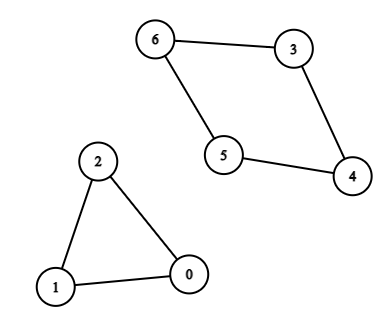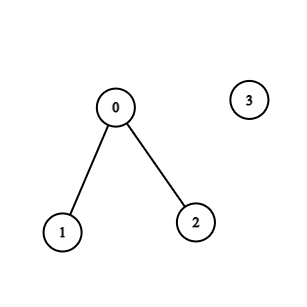There is a bi-directional graph with n vertices, where each vertex is labeled from 0 to n - 1. The edges in the graph are represented by a given 2D integer array edges, where edges[i] = [ui, vi] denotes an edge between vertex ui and vertex vi. Every vertex pair is connected by at most one edge, and no vertex has an edge to itself.
Return the length of the shortest cycle in the graph. If no cycle exists, return -1.
A cycle is a path that starts and ends at the same node, and each edge in the path is used only once.
Example 1:
Input: n = 7, edges = [[0,1],[1,2],[2,0],[3,4],[4,5],[5,6],[6,3]] Output: 3 Explanation: The cycle with the smallest length is : 0 -> 1 -> 2 -> 0
Example 2:
Input: n = 4, edges = [[0,1],[0,2]] Output: -1 Explanation: There are no cycles in this graph.
Constraints:
2 <= n <= 10001 <= edges.length <= 1000edges[i].length == 20 <= ui, vi < nui != vi- There are no repeated edges.
Solution 1: Enumerate edges + BFS
We first construct the adjacency list
Then we enumerate the two-directional edge
The time complexity is
Solution 2: Enumerate points + BFS
Similar to Solution 1, we first construct the adjacency list
Then we enumerate the vertex
The time complexity is
class Solution:
def findShortestCycle(self, n: int, edges: List[List[int]]) -> int:
def bfs(u: int, v: int) -> int:
dist = [inf] * n
dist[u] = 0
q = deque([u])
while q:
i = q.popleft()
for j in g[i]:
if (i, j) != (u, v) and (j, i) != (u, v) and dist[j] == inf:
dist[j] = dist[i] + 1
q.append(j)
return dist[v] + 1
g = defaultdict(set)
for u, v in edges:
g[u].add(v)
g[v].add(u)
ans = min(bfs(u, v) for u, v in edges)
return ans if ans < inf else -1class Solution:
def findShortestCycle(self, n: int, edges: List[List[int]]) -> int:
def bfs(u: int) -> int:
dist = [-1] * n
dist[u] = 0
q = deque([(u, -1)])
ans = inf
while q:
u, fa = q.popleft()
for v in g[u]:
if dist[v] < 0:
dist[v] = dist[u] + 1
q.append((v, u))
elif v != fa:
ans = min(ans, dist[u] + dist[v] + 1)
return ans
g = defaultdict(list)
for u, v in edges:
g[u].append(v)
g[v].append(u)
ans = min(bfs(i) for i in range(n))
return ans if ans < inf else -1class Solution {
private List<Integer>[] g;
private final int inf = 1 << 30;
public int findShortestCycle(int n, int[][] edges) {
g = new List[n];
Arrays.setAll(g, k -> new ArrayList<>());
for (var e : edges) {
int u = e[0], v = e[1];
g[u].add(v);
g[v].add(u);
}
int ans = inf;
for (var e : edges) {
int u = e[0], v = e[1];
ans = Math.min(ans, bfs(u, v));
}
return ans < inf ? ans : -1;
}
private int bfs(int u, int v) {
int[] dist = new int[g.length];
Arrays.fill(dist, inf);
dist[u] = 0;
Deque<Integer> q = new ArrayDeque<>();
q.offer(u);
while (!q.isEmpty()) {
int i = q.poll();
for (int j : g[i]) {
if ((i == u && j == v) || (i == v && j == u) || dist[j] != inf) {
continue;
}
dist[j] = dist[i] + 1;
q.offer(j);
}
}
return dist[v] + 1;
}
}class Solution {
private List<Integer>[] g;
private final int inf = 1 << 30;
public int findShortestCycle(int n, int[][] edges) {
g = new List[n];
Arrays.setAll(g, k -> new ArrayList<>());
for (var e : edges) {
int u = e[0], v = e[1];
g[u].add(v);
g[v].add(u);
}
int ans = inf;
for (int i = 0; i < n; ++i) {
ans = Math.min(ans, bfs(i));
}
return ans < inf ? ans : -1;
}
private int bfs(int u) {
int[] dist = new int[g.length];
Arrays.fill(dist, -1);
dist[u] = 0;
Deque<int[]> q = new ArrayDeque<>();
q.offer(new int[] {u, -1});
int ans = inf;
while (!q.isEmpty()) {
var p = q.poll();
u = p[0];
int fa = p[1];
for (int v : g[u]) {
if (dist[v] < 0) {
dist[v] = dist[u] + 1;
q.offer(new int[] {v, u});
} else if (v != fa) {
ans = Math.min(ans, dist[u] + dist[v] + 1);
}
}
}
return ans;
}
}class Solution {
public:
int findShortestCycle(int n, vector<vector<int>>& edges) {
vector<vector<int>> g(n);
for (auto& e : edges) {
int u = e[0], v = e[1];
g[u].push_back(v);
g[v].push_back(u);
}
const int inf = 1 << 30;
auto bfs = [&](int u, int v) -> int {
int dist[n];
fill(dist, dist + n, inf);
dist[u] = 0;
queue<int> q{{u}};
while (!q.empty()) {
int i = q.front();
q.pop();
for (int j : g[i]) {
if ((i == u && j == v) || (i == v && j == u) || dist[j] != inf) {
continue;
}
dist[j] = dist[i] + 1;
q.push(j);
}
}
return dist[v] + 1;
};
int ans = inf;
for (auto& e : edges) {
int u = e[0], v = e[1];
ans = min(ans, bfs(u, v));
}
return ans < inf ? ans : -1;
}
};class Solution {
public:
int findShortestCycle(int n, vector<vector<int>>& edges) {
vector<vector<int>> g(n);
for (auto& e : edges) {
int u = e[0], v = e[1];
g[u].push_back(v);
g[v].push_back(u);
}
const int inf = 1 << 30;
auto bfs = [&](int u) -> int {
int dist[n];
memset(dist, -1, sizeof(dist));
dist[u] = 0;
queue<pair<int, int>> q;
q.emplace(u, -1);
int ans = inf;
while (!q.empty()) {
auto p = q.front();
u = p.first;
int fa = p.second;
q.pop();
for (int v : g[u]) {
if (dist[v] < 0) {
dist[v] = dist[u] + 1;
q.emplace(v, u);
} else if (v != fa) {
ans = min(ans, dist[u] + dist[v] + 1);
}
}
}
return ans;
};
int ans = inf;
for (int i = 0; i < n; ++i) {
ans = min(ans, bfs(i));
}
return ans < inf ? ans : -1;
}
};func findShortestCycle(n int, edges [][]int) int {
g := make([][]int, n)
for _, e := range edges {
u, v := e[0], e[1]
g[u] = append(g[u], v)
g[v] = append(g[v], u)
}
const inf = 1 << 30
bfs := func(u, v int) int {
dist := make([]int, n)
for i := range dist {
dist[i] = inf
}
dist[u] = 0
q := []int{u}
for len(q) > 0 {
i := q[0]
q = q[1:]
for _, j := range g[i] {
if (i == u && j == v) || (i == v && j == u) || dist[j] != inf {
continue
}
dist[j] = dist[i] + 1
q = append(q, j)
}
}
return dist[v] + 1
}
ans := inf
for _, e := range edges {
u, v := e[0], e[1]
ans = min(ans, bfs(u, v))
}
if ans < inf {
return ans
}
return -1
}
func min(a, b int) int {
if a < b {
return a
}
return b
}func findShortestCycle(n int, edges [][]int) int {
g := make([][]int, n)
for _, e := range edges {
u, v := e[0], e[1]
g[u] = append(g[u], v)
g[v] = append(g[v], u)
}
const inf = 1 << 30
bfs := func(u int) int {
dist := make([]int, n)
for i := range dist {
dist[i] = -1
}
dist[u] = 0
q := [][2]int{{u, -1}}
ans := inf
for len(q) > 0 {
p := q[0]
u = p[0]
fa := p[1]
q = q[1:]
for _, v := range g[u] {
if dist[v] < 0 {
dist[v] = dist[u] + 1
q = append(q, [2]int{v, u})
} else if v != fa {
ans = min(ans, dist[u]+dist[v]+1)
}
}
}
return ans
}
ans := inf
for i := 0; i < n; i++ {
ans = min(ans, bfs(i))
}
if ans < inf {
return ans
}
return -1
}
func min(a, b int) int {
if a < b {
return a
}
return b
}function findShortestCycle(n: number, edges: number[][]): number {
const g: number[][] = new Array(n).fill(0).map(() => []);
for (const [u, v] of edges) {
g[u].push(v);
g[v].push(u);
}
const inf = 1 << 30;
let ans = inf;
const bfs = (u: number, v: number) => {
const dist: number[] = new Array(n).fill(inf);
dist[u] = 0;
const q: number[] = [u];
while (q.length) {
const i = q.shift()!;
for (const j of g[i]) {
if (
(i == u && j == v) ||
(i == v && j == u) ||
dist[j] != inf
) {
continue;
}
dist[j] = dist[i] + 1;
q.push(j);
}
}
return 1 + dist[v];
};
for (const [u, v] of edges) {
ans = Math.min(ans, bfs(u, v));
}
return ans < inf ? ans : -1;
}function findShortestCycle(n: number, edges: number[][]): number {
const g: number[][] = new Array(n).fill(0).map(() => []);
for (const [u, v] of edges) {
g[u].push(v);
g[v].push(u);
}
const inf = 1 << 30;
let ans = inf;
const bfs = (u: number) => {
const dist: number[] = new Array(n).fill(-1);
dist[u] = 0;
const q: number[][] = [[u, -1]];
let ans = inf;
while (q.length) {
const p = q.shift()!;
u = p[0];
const fa = p[1];
for (const v of g[u]) {
if (dist[v] < 0) {
dist[v] = dist[u] + 1;
q.push([v, u]);
} else if (v !== fa) {
ans = Math.min(ans, dist[u] + dist[v] + 1);
}
}
}
return ans;
};
for (let i = 0; i < n; ++i) {
ans = Math.min(ans, bfs(i));
}
return ans < inf ? ans : -1;
}

